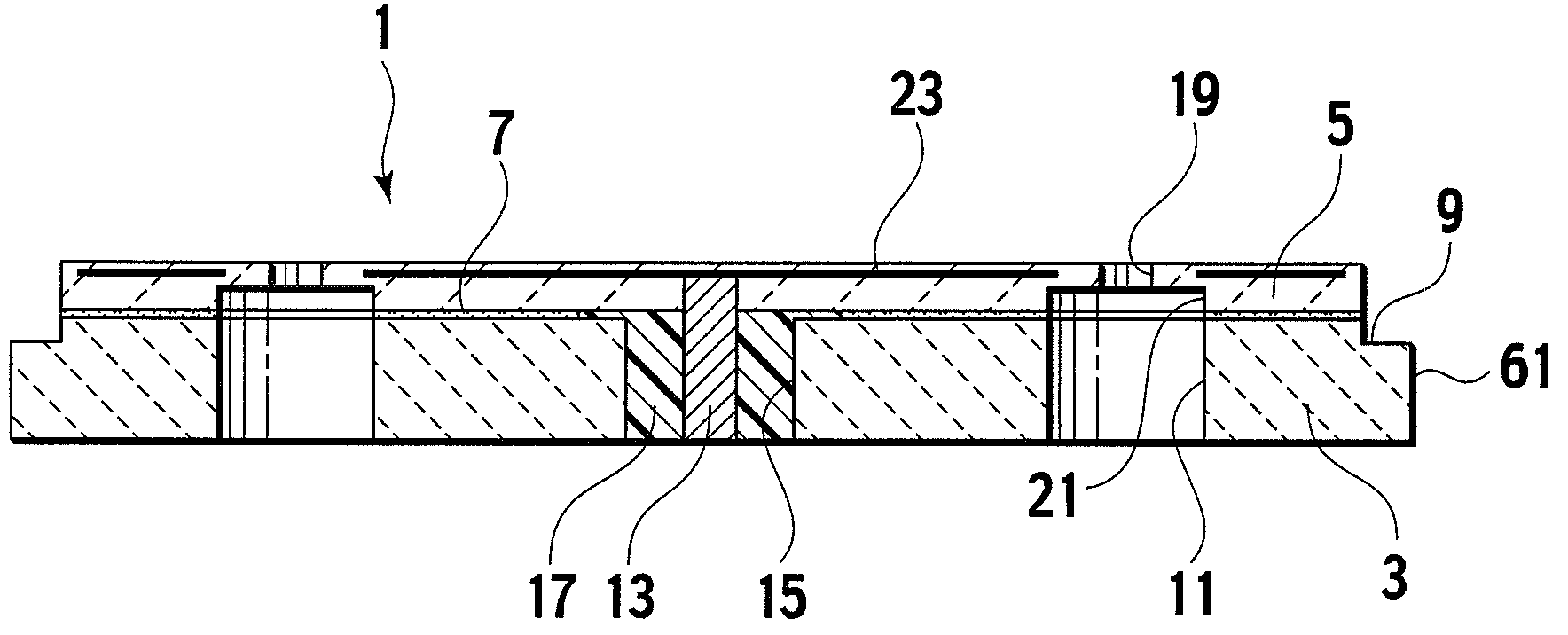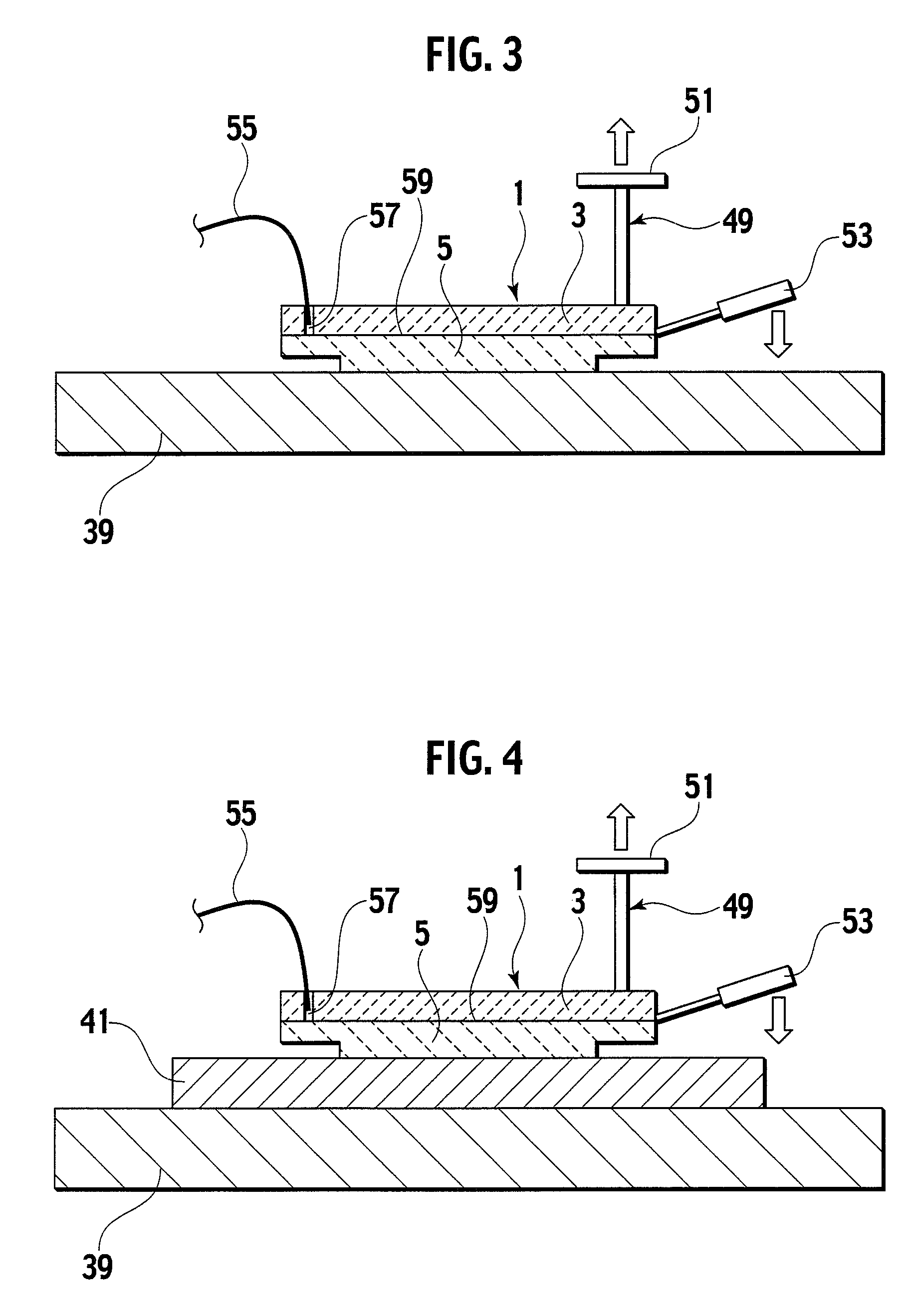Disassembly method and reuse method of substrate mounting member
a technology of substrate mounting and disassembly method, which is applied in the direction of photosensitive materials, instruments, processed materials, etc., can solve the problems of affecting the quality of substrate mounting, so as to reduce the quantity of waste and reduce the cost
- Summary
- Abstract
- Description
- Claims
- Application Information
AI Technical Summary
Benefits of technology
Problems solved by technology
Method used
Image
Examples
first embodiment
[0023]First, a description will be made of a first embodiment according to the present invention.
[0024]As shown in FIG. 1, a substrate mounting member 1 according to this embodiment includes a base member 3 made of aluminum, an aluminum alloy, or the like, an electrostatic chuck 5 which holds a semiconductor wafer, and an organic adhesive layer 7 which bonds the base member 3 and the electrostatic chuck 5 to each other. Specifically, the substrate mounting member 1 is a member formed by bonding the base member 3 and the electrostatic chuck 5 to each other through the organic adhesive layer 7.
[0025]The base member 3 has a disc-like outer shape, in which a step difference portion 9 is formed on an upper end portion of an outer circumferential surface 61. Moreover, a plurality of housing holes 11 which house a support plate (not shown) for lift pins therein are formed at an equal interval along a circumferential direction so as to penetrate the base member 3 in a plate thickness direct...
second embodiment
[0063]In the above-described first embodiment, the description has been made of the disassembly method for separating the base member 3 from the substrate mounting member 1. In a second embodiment, a description will be made of a method for reusing the separated electrostatic chuck 5 and base member 3.
[0064]In some case, the residue of the organic adhesive layer 7 is partially adhered onto the bonding surface of at least either the electrostatic chuck 5 or the base member 3, which as been separated from each other in the first embodiment. In this case, it is preferable to dissolve the residue by immersing the residue into the organic solvent, or to scrape off the residue by using the pallet and the like.
[0065]Subsequently, the separated base member 3 and electrostatic chuck 5 are bonded to each other by using the adhesive or the bonding sheet, thus making it possible to reuse the bonded base member 3 and electrostatic chuck 5 as a new substrate mounting member 1.
example 1
[0067]As shown in FIG. 1, the substrate mounting member 1 for use in Example 1 is a member formed by bonding the base member 3 made of aluminum and the electrostatic chuck 5 made of aluminum nitride to each other through the organic adhesive layer 7. Three lift pin holes 19 were drilled in the electrostatic chuck 5 along the circumferential direction thereof, and the spot facing portions 21 were formed on the lower portions of the lift pin holes 19. A weight of the base member 3 was 3400 g. Moreover, with regard to the type of the organic adhesive layer 7, as shown in Table 1, thermosetting acrylic resin, thermosetting silicon resin, thermosetting polyimide resin, thermosetting epoxy resin, thermosetting acrylic resin, and thermoplastic acrylic resin were used. The thermal decomposition starting temperatures and thermal decomposition ending temperatures of the organic adhesive layers 7 made of these resins were measured. Results of the measurements were obtained as shown in Table 1....
PUM
| Property | Measurement | Unit |
|---|---|---|
| height | aaaaa | aaaaa |
| temperature | aaaaa | aaaaa |
| weight | aaaaa | aaaaa |
Abstract
Description
Claims
Application Information
 Login to View More
Login to View More - R&D
- Intellectual Property
- Life Sciences
- Materials
- Tech Scout
- Unparalleled Data Quality
- Higher Quality Content
- 60% Fewer Hallucinations
Browse by: Latest US Patents, China's latest patents, Technical Efficacy Thesaurus, Application Domain, Technology Topic, Popular Technical Reports.
© 2025 PatSnap. All rights reserved.Legal|Privacy policy|Modern Slavery Act Transparency Statement|Sitemap|About US| Contact US: help@patsnap.com



